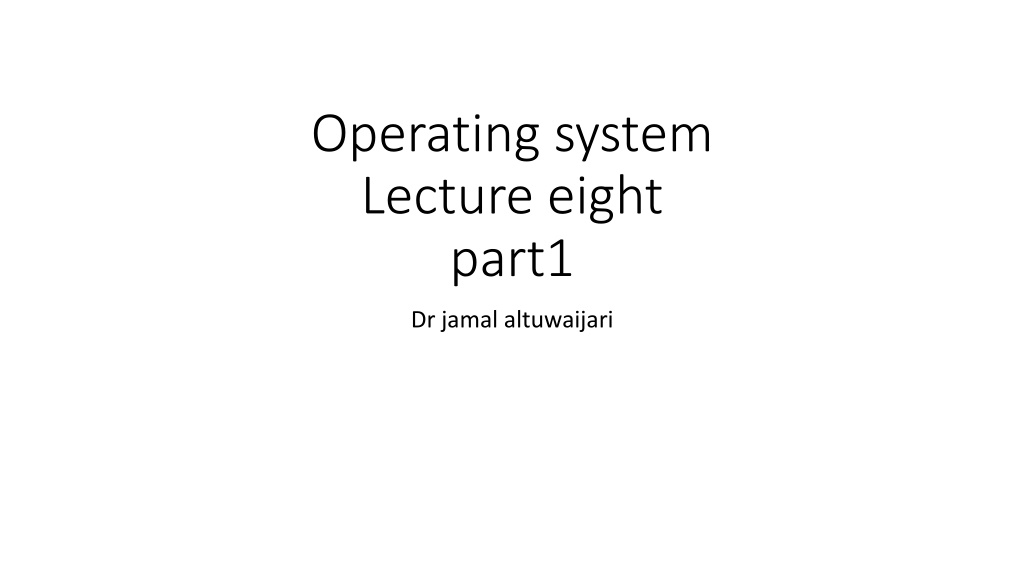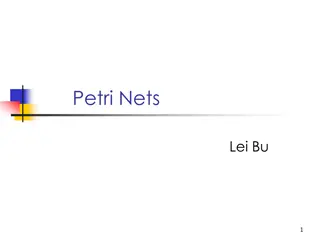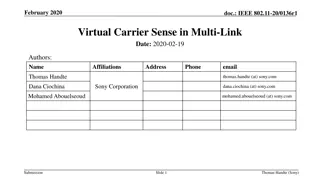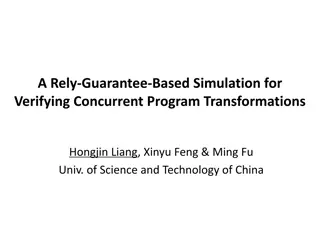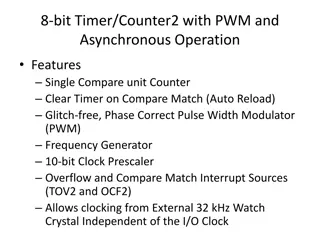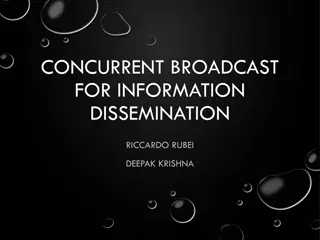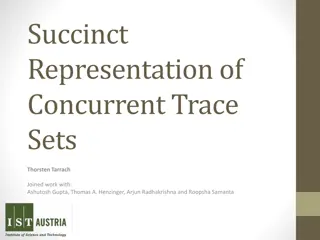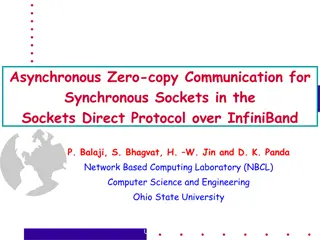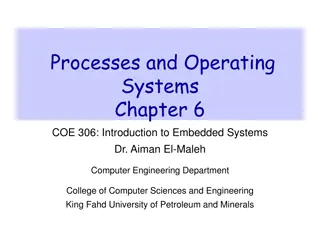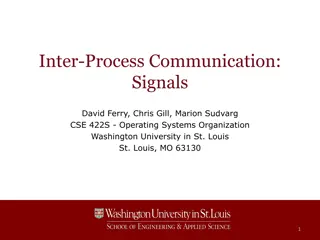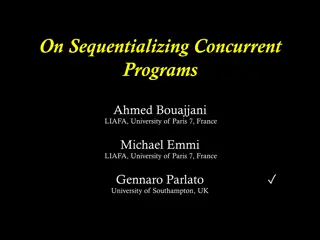Understanding Asynchronous and Concurrent Processes in Operating Systems
Exploring the concepts of asynchronous and concurrent processes in operating systems, this lecture covers how processes can function independently or require occasional synchronization. It also delves into parallel processing complexities, control structures for indicating parallelism, precedence graphs, and mutual exclusion scenarios in OS processes.
Download Presentation

Please find below an Image/Link to download the presentation.
The content on the website is provided AS IS for your information and personal use only. It may not be sold, licensed, or shared on other websites without obtaining consent from the author. Download presentation by click this link. If you encounter any issues during the download, it is possible that the publisher has removed the file from their server.
E N D
Presentation Transcript
Operating system Lecture eight part1 Dr jamal altuwaijari
8 8. Asynchronous Concurrent Process . Asynchronous Concurrent Process Processes are concurrent if they exit at the same time. Concurrent processes can function completely in independently of one another, or they can be a synchronous which means that they .require occasional synchronization and cooperation.
8.1 8.1 parallel processing parallel processing If certain can logically be preformed in parallel then computer will physically perform them is parallel. Parallel processing is complex for several reasons: a. People seem better able to do one activity at a time. b. It is difficult and time consuming to determine what activities can and can not be performed in parallel c. Parallel program are much more difficult to debug than sequential programs. d. Asynchronous processes must occasionally interact with one another and these interactions can be complex. e. Parallel programs are much more difficult to prove correct than sequential programs.
8.2 8.2 a control structure for indicating parallelism a control structure for indicating parallelism Many programming languages constructs for indicating parallelism some of them as follows: a. One statement indicating the sequential execution is to split into several parallel execution sequences (threads). b. One statement indicating that certain parallel execution sequences are to merge and sequential execution is to resume. These statements occurring pairs and are commonly called parbegin parend (for being and end parallel execution) or cobegin coend (for being and end concurrent execution).
8.3 8.3 precedence graph precedence graph A precedence graph is a directed a cyclic graph whose nodes correspond to individual statements. An edge from node Si to node Sj means that statement Sj cart be executed. only after statement si has completed execution. Example: Consider the following program segment which performs some simple arithmetic operations:
8.3 8.3 precedence graph precedence graph S1 a:=x+y; S2 b:=z+1; S3 c:=a S4 w:=c+1; S1 and S2 could be executed concurrently since neither depends upon the other. This program could be rewritten using parbegin/ parend construct. Parbegin A=x +y; B=z+ I; Parend: C:=a-b; w:=c +1;
8.4 8.4 mutual Exclusion mutual Exclusion Consider a OS processes P 1 and P2 sharing one variable called line-count of type integer. Assume at time TO the value of the this variable 21637 and each process has its own copy of the code: LOAD line-count ADD 1 STORE line-count Now suppose the process p1 execute the load and add instructions, this leaving 21688 in an accumulator. ___________________________________________________________ Then the process Pi loses the processor (through a T.Q expiration to second peeress (P2) now executes all three above instructions, thus setting line-count to 21688. P2 loses the processor to P1 which then continues by executing the store instruction by executing the store instruction also niacin 21688 into line-count the system has lost track of one of the line-count, where the correct total should have been 21688. The reason of this incorrect result is the writing of the shared variable line-count. This problem can be solved by giving each process exclusive access to line-count (the shared variable).
* * Mutual Exclusion definition Mutual Exclusion definition While one process modify the shared variable, all other processes desiring to do so at the same time (moment) should be kept waiting; when that process has finished accessing the shared variable, one of the processes waiting to do so should be allowed to proceed. In this function, each process accessing the shared data excludes all other from doing so simultaneously. This is called mutual exclusion.
8.5 8.5 Critical Section Critical Section Mutual exclusion needs to be enforced only when processes access shared modifiable data. In each process the segment of code deal with the shared modifiable data called a critical section (or critical region). The important feature is that, when one process is executing in its critical section. on other process is to allowed to execute in its critical section. Thus the execution of critical sections by the processes is mutually exclusive in time. Each process must request permission to enter its critical section. The section of code implementing the request is the entry section. The critical section may he followed by all exit section. The remaining code is the remaining section.
8.5 8.5 Critical Section Critical Section A solution to the critical-section problem must satisfy the following requirements: a. Mutual Exclusion: if process Pi is executing in its critical section then no other processes can be executing in their critical section. b. Progress: if no process in its C.S and there some process that wish to enter their C.S. then only those processes that are not executing in their remainder section can participate in the decision of which will enter its CS next. c. Bounded waiting: there exit a bound on the number of times that other processes are allowed to enter their C.S after a process has made a request to enter its CS and before that request is granted.
8.6 8.6 Two Two- -process solution process solution when presenting an algorithm, we define only the variable used for synchronization purposes and describe only a typical process Pi whose general structure is shown in the following figure 8.1. In this section we shall describe the algorithms that are application to only two processes at a time. The processes are numbered Po & Ps for convenience when presenting P1 we use Pi to denote the other process that is j=1+i
Algorithm 1 let the processes shared a common integer variable turn=0 or if turn=i the Pi allowed to execute in its ethical. The structure of this algorithm is shown in figure 8.2 The solution ensure that only one process at a time can be in its C.S. But it does not satisfy the process requirement since it requires alternation of processes in the execution of C.S example, if turn=0 and P1 is ready to enter its CS. P1 can not do so even though P0 may be in its remainder section. Repent
Algorithm 2 The problem with alg. I is that does not retain sufficient information about the state of each process; it remembers only which process is allowed to enter C.S . To remedy this problem we can replace the variable tern with the following array: var flag: array [0..I] of boolean The element of the array are initialized to false. . If flag [i] is true this variable indicate that pi is ready to enter the critical section. The structure of process is shown in figure Repeat Now both Po and PI arc looping forever in while statements. The above case may happen ten the Po is interrupted and the CPU switching to process Pi. So both processes try to be in the C.S at the same lime, violating the mutual exclusion requirement
algorithm 3 By combing the key ideas of Alg. I and Ma. 2 we obtain a correct solution to the C.S problem where all three requirements are met. The two processes share two variables: Var flag :array [0.1] of Boolean; Turn 0.. I; Initially flag [0] = flag[1] = false. The value of turn either I or 0. The structure of process Pi as in figure RA the final %ante of turn decides which of the two processes is allowed to enter its critical section . this Alg. 3 satisfy the C.S requirements . Repeat
